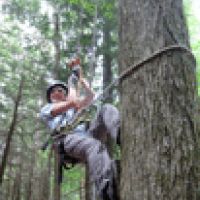Gaines et al., 2013
Patterns in tree water extraction depth at the Susquehanna Shale Hills Critical Zone Observatory in central Pennsylvania
Katie P Gaines, David Eissenstat, and Henry Lin (2013)
ESA Annual Meeting,Minneapolis, Minnesota, August 4-9, 2013
-
Shale Hills, GRAD STUDENT
-
Shale Hills, INVESTIGATOR
-
IML, Shale Hills, INVESTIGATOR
Abstract
Background/Question/Methods
The vertical distribution and function of tree roots in the soil affect ecosystem water balance and may also drive species distributions and competition. However, it is not well understood what factors drive the depth of water uptake. To this end, we studied the role of tree species, slope position, and soil characteristics on depth of water extraction in 9 temperate tree species in the Susquehanna Shale Hills Critical Zone Observatory in central Pennsylvania. We used oxygen and hydrogen stable isotopes of water at natural abundance levels to identify the source or sources of water in tree tissues. Water that is subjected to evaporation (i.e. summertime precipitation and shallow soil water) has a more enriched isotopic signature than water that has not been subjected to evaporation (winter precipitation and deep soil water). Over two field seasons, small canopy branches were sampled from a total of 57 trees. Water was distilled from branches and then analyzed with stable isotope mass spectroscopy. Ground water, precipitation, and soil water at various depths were also sampled as potential water sources.
Results/Conclusions
It was estimated that roots reached water sources of up to 100 cm, with most trees tapping water less than 50 cm deep. Trends for rooting depth were observed for tree location and date of sampling, with trees on the valley floor tending to have deeper effective rooting depth on average than trees on ridge top locations, and with trees tapping deeper sources of water as the summer growing season progressed. We see an opportunity for refining the parameter of rooting depth in watershed models using spatial and temporal variability in order to improve our understanding of the interaction of trees with the water cycle over larger scales.
Citation
Katie P Gaines, David Eissenstat, and Henry Lin (2013): Patterns in tree water extraction depth at the Susquehanna Shale Hills Critical Zone Observatory in central Pennsylvania. ESA Annual Meeting,Minneapolis, Minnesota, August 4-9, 2013.
 This Paper/Book acknowledges NSF CZO grant support.
This Paper/Book acknowledges NSF CZO grant support.
Explore Further




